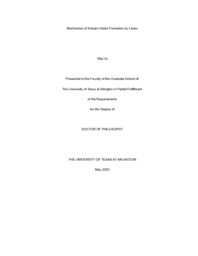
ATTENTION: The works hosted here are being migrated to a new repository that will consolidate resources, improve discoverability, and better show UTA's research impact on the global community. We will update authors as the migration progresses. Please see MavMatrix for more information.
Show simple item record
| dc.contributor.advisor | Liu, Chaoqun | |
| dc.creator | Yu, Yifei | |
| dc.date.accessioned | 2023-06-14T17:06:26Z | |
| dc.date.available | 2023-06-14T17:06:26Z | |
| dc.date.created | 2023-05 | |
| dc.date.issued | 2023-05-11 | |
| dc.date.submitted | May 2023 | |
| dc.identifier.uri | http://hdl.handle.net/10106/31246 | |
| dc.description.abstract | Turbulence is still a mystery for human after more than one century’s development of fluid dynamics. Hairpin vortex formation is regarded as an essential process for a laminar flow transition to the turbulent flow. A new correct third generation vortex identification method, Liutex, was proposed in 2018, which can represent local rotation direction and reveal the local angular speed correctly. Using this powerful tool, the mechanism of hairpin vortex formation is re-examined. This dissertation (1) explains the mechanism of hairpin vortex formation by solving Orr-Sommerfeld equation using Chebyshev spectrum method (2) observes the DNS result of flat plate boundary layer transition (3) develops objective Liutex (4) finds correlations between Liutex and other popular vortex identification methods (5) defines principal coordinate and principal decomposition (6) defines Liutex core line. Formation of hairpin vortex usually goes through three stages: (1) spanwise vortex (2) Λ-vortex (3) hairpin vortex. Spanwise vortex is formed because the Blasius solution has unstable 2D mode which is called Tollmien–Schlichting wave and this mode leads to the spanwise vortex. 3D mode enforced in DNS case is originally stable for Blasius solution profile, however, with the development of the flow, the base flow velocity profile is changed. Use the new velocity profile as the base flow, we will find the 3D mode becomes unstable. Λ-vortex appears with the growth of the 3D perturbation. The “eject” and “sweep” motion of Λ-vortex generate strong shear region. This region is unstable and results in the hairpin vortex. The Λ-and hairpin vortex roll up since z-component of Liutex is positive. Principal decomposition decomposes velocity gradient tensor into parts with clear physical meanings. Objective Liutex can obtain Liutex structure in an inertial frame from the data collected in the non-inertial frames. Liutex core line method is threshold-free and provides a unique vortex structure. Correlation analysis between Liutex and other methods show other methods are contaminated by shear or stretching. | |
| dc.format.mimetype | application/pdf | |
| dc.language.iso | en_US | |
| dc.subject | Turbulence | |
| dc.subject | Liutex | |
| dc.subject | Flow transitions | |
| dc.subject | Hairpin vortices | |
| dc.subject | Linear stability theory | |
| dc.subject | Orr-Sommerfeld equation | |
| dc.title | Mechanism of Hairpin Vortex Formation by Liutex | |
| dc.type | Thesis | |
| dc.date.updated | 2023-06-14T17:06:26Z | |
| thesis.degree.department | Mathematics | |
| thesis.degree.grantor | The University of Texas at Arlington | |
| thesis.degree.level | Doctoral | |
| thesis.degree.name | Doctor of Philosophy in Mathematics | |
| dc.type.material | text | |
| dc.creator.orcid | 0000-0002-1213-0801 | |
Files in this item
- Name:
- YU-DISSERTATION-2023.pdf
- Size:
- 4.621Mb
- Format:
- PDF
This item appears in the following Collection(s)
Show simple item record


